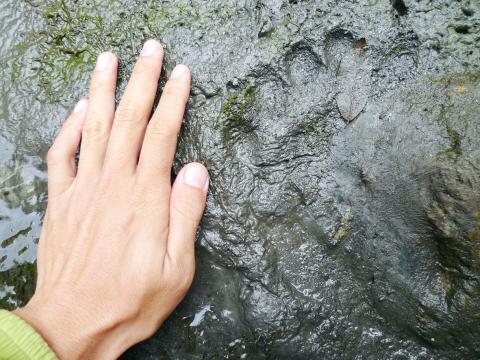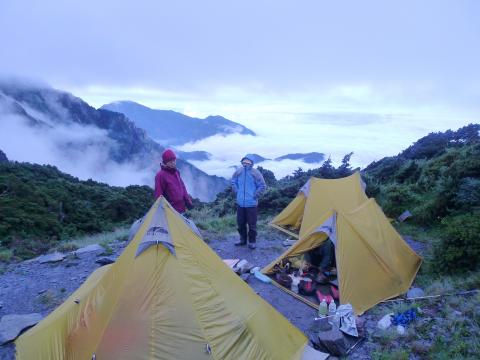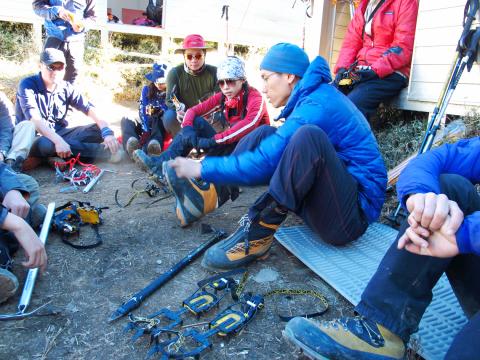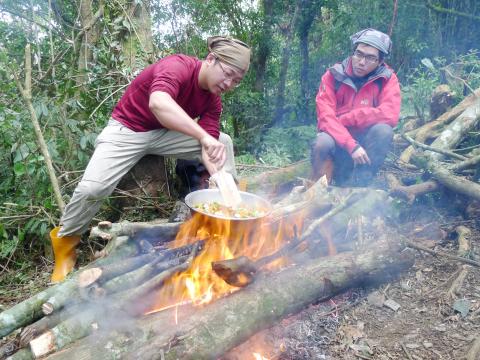People like to talk about Taiwan’s 100 peaks (百岳), a shorthand reference to the quite considerable number of mountains along Taiwan’s Central Mountain Range that exceed 3,000m in height. The 100 peaks, and the many mountain trails in the high places of the Central Mountain Range, are popular with Taiwan’s mountain climbing fraternity, but despite the wide appreciation of their scenic beauty, the physical demands of exploring these peaks mean only a very small minority of Taiwanese have ever experienced these mountains in person.
This is something that Lin Cheng-han (林政翰), a long-time mountaineer and founder of Miasan Outdoor Center (米亞桑戶外中心), wants to change. His aim is not simply to get people up into the mountains, but also to develop their understanding of a unique mountain environment. In the past, the high mountains were the preserve of Taiwan’s many trekking associations, ad hoc gatherings composed mostly of students and hearty retirees, who often, though far from exclusively, saw climbing as a test of stamina. In recent years, there has been a burgeoning growth in more commercial climbing groups in which trekking companies cater to the demands of tourists by providing convenience and comfort, but which also lack commitment to educating the public about Taiwan’s mountain environment.
Slightly over a decade ago, my own experience as a novice climber was one of bewilderment and occasional fear. Pre-trek meetings were usually half-hour briefings about the route, which to someone without map reading skills were completely incomprehensible, the handing out of a list of essential equipment that I should procure, and encouraging remarks about not worrying too much as all would be fine.

Photo Courtesy of Lin Cheng-han
This is how I found myself in running shoes, inadequate thermals, a superannuated backpack and a woeful state of physical fitness preparing to make a four-day assent of Nanhu Mountain (南湖大山) with nearly 30 others, uncertain what I had got myself into. My climbing companions were friendly and often sympathetic, but this did not altogether compensate for my lack of knowledge and proper preparation. It was not a situation that I would have wished on anyone I greatly cared for.
While the large loose groups of the trekking associations which provided my own introduction to climbing in Taiwan are still a major presence on the mountain, there are those in the mountain climbing community who are eager to change Taiwan’s climbing culture.
For Lin, the way to do this is through a mixture of old knowledge and new technology. Miasan, with its mix of educational and social center, is designed to cater to people interested in not just conquering Taiwan’s 100 peaks, but in actually getting to know the mountains. For this reason, Lin is a strong proponent not just of climbing mountains, but learning about them and the skills required to survive outdoors.

Photo Courtesy of Lin Cheng-han
“Without these skills you are never on equal terms with the mountain,” he said. “You can’t really know the mountains if you can’t survive there.”
Lin, a former rock climber competing at the national level who has also taken part in research projects on the Formosan Black Bear and Clouded Leopard, said that a seminal experience for him in appreciating and learning about Taiwan’s mountains was the long periods of time he spent working closely with Taiwan’s Aboriginal people.
“My association with Taiwan’s aborigines has had a huge influence on me,” Lin said, “It has had a profound impact on the way I teach climbers and lead climbing groups. I have spent a lot of time with Aboriginal hunters up in the mountains, and I have absorbed their style of oral transmission, which is different from a formal type of teaching… It’s kind of difficult to express, but I feel that chatting, demonstrations and interaction is a much more effective way of passing on knowledge to climbers.”

Photo Courtesy of Lin Cheng-han
Lin’s association with Taiwan’s Aborigines has also led him to include a course titled Aboriginal Hunting School, in which he turns back the clock and teaches climbers basic skills that constitute an important part of an Aboriginal hunters knowledge. It includes everything from making an impromptu shelter to basic tracking.
“This knowledge allows climbers to appreciate the mountain environment in a more intimate fashion. Most climbers at most will look at the scenery, but there is plenty more to see: the marks and tracks of various animals and insects. Often, even if they notice them, they can’t identify them,” he said. “Taiwan does not actually have many mountains that require advanced technical skills [to climb],” Lin said. “Climbing here is more about appreciating a new environment, so I have designed a number of activities to make the most of this.”
Although mountain climbing has grown in popularity in Taiwan, Lin does not believe that either knowledge or respect of the mountains is trickling down to the wider public.

Photo Courtesy of Lin Cheng-han
“I don’t think there has been much change in the culture of mountain climbing in Taiwan,” Lin said. “There are an increasing number of small groups, but another trend over the last 10 years has been the increase in purely commercial climbing groups… Climbing has become a form of tourism… There is nothing inherently wrong with such groups, but often, in catering to their customers, travel companies ignore some environmental details, such as dumping kitchen waste on the mountain. They are also disinclined to correct or instruct their paying customers about proper behavior on the mountain, so people do not learn the best way to interact with this environment.”
Whether climbing associations or travel companies, large groups remain the norm, and there is inevitably an impact on the environment and on safety. “Many commercial companies have a 1:10 or 1:12 ratio of guides to climbers, and when many of these are inexperienced, this has safety repercussions,” Lin said.
“One of the features of climbs with Miasan is that the groups themselves are quite small, but we get a lot of repeat customers. There are some who [have learned enough] that they don’t really need to take part in the classes, but they sign up for new courses anyway.”
Lin emphasizes the use of modern equipment that allows climbers to travel relatively light, or which reduce the physical impact of climbing — the use of climbing sticks and head straps — lowering the entry level of physical fitness required for novices, as well as instruction in simple techniques, such as correct breathing and walking style. With smaller groups and programs that emphasize specific learning goals, Lin believes that he is able to provide something more to the exploration of Taiwan’s mountain environment.
Miasan, with its wide variety of classes ranging from easy treks for beginners to mountain survival skills for more seasoned climbers, seeks to reveal different aspects of Taiwan’s mountain environment, and open up a seam in Taiwan’s mountain climbing culture in which knowledge and observation are as important as climbing prowess.
More information about Miasan Outdoor Center can be found at www.miasan.com.

This month the government ordered a one-year block of Xiaohongshu (小紅書) or Rednote, a Chinese social media platform with more than 3 million users in Taiwan. The government pointed to widespread fraud activity on the platform, along with cybersecurity failures. Officials said that they had reached out to the company and asked it to change. However, they received no response. The pro-China parties, the Chinese Nationalist Party (KMT) and Taiwan People’s Party (TPP), immediately swung into action, denouncing the ban as an attack on free speech. This “free speech” claim was then echoed by the People’s Republic of China (PRC),

Exceptions to the rule are sometimes revealing. For a brief few years, there was an emerging ideological split between the Democratic Progressive Party (DPP) and Chinese Nationalist Party (KMT) that appeared to be pushing the DPP in a direction that would be considered more liberal, and the KMT more conservative. In the previous column, “The KMT-DPP’s bureaucrat-led developmental state” (Dec. 11, page 12), we examined how Taiwan’s democratic system developed, and how both the two main parties largely accepted a similar consensus on how Taiwan should be run domestically and did not split along the left-right lines more familiar in

Specialty sandwiches loaded with the contents of an entire charcuterie board, overflowing with sauces, creams and all manner of creative add-ons, is perhaps one of the biggest global food trends of this year. From London to New York, lines form down the block for mortadella, burrata, pistachio and more stuffed between slices of fresh sourdough, rye or focaccia. To try the trend in Taipei, Munchies Mafia is for sure the spot — could this be the best sandwich in town? Carlos from Spain and Sergio from Mexico opened this spot just seven months ago. The two met working in the

Many people in Taiwan first learned about universal basic income (UBI) — the idea that the government should provide regular, no-strings-attached payments to each citizen — in 2019. While seeking the Democratic nomination for the 2020 US presidential election, Andrew Yang, a politician of Taiwanese descent, said that, if elected, he’d institute a UBI of US$1,000 per month to “get the economic boot off of people’s throats, allowing them to lift their heads up, breathe, and get excited for the future.” His campaign petered out, but the concept of UBI hasn’t gone away. Throughout the industrialized world, there are fears that